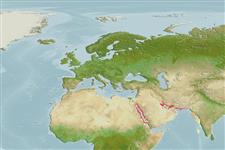>
Gobiiformes (Gobies) >
Xenisthmidae (Collared wrigglers)
Etymology: Xenisthmus: Greek, xenos = strange + Greek, isthmos = throat, narrow passage (Ref. 45335); oligoporus: Name from Greek 'oligos' for few and 'poros' for hole; referring to the relatively low number of sensory pores on the head; noun in apposition..
Environment: milieu / climate zone / depth range / distribution range
বাস্তুসংস্থান
সামুদ্রিক রীফ সংশ্লিষ্ট; গভীরতার পরিসীমা 6 - 13 m (Ref. 115539). Tropical
Western Indian Ocean: Red Sea, Saudi Arabia.
আকৃতি / ওজন / Age
Maturity: Lm ? range ? - ? cm
Max length : 2.3 cm SL পুরুষ/ লিঙ্গ অনিধর্ারিত ; (Ref. 115539); 2.5 cm SL (female)
পৃষ্ঠীয় কাঁটা (মোট ): 7; পৃষ্ঠীয় নরম পাখনা দন্ড (মোট ): 14-15; পায়ূ কাঁটা 1; পায়ূর নরম পাখনা্তুন্ড: 13 - 14; কশেরুকা : 26. This species is distinguished from it congeners in having a reduced number of cephalic
sensory pores (without A, I, J, K, P and Q pores) and in having 14-15 segmented rays in the second dorsal fin (Ref. 115539).
Found in sandy areas (Ref. 115539).
Life cycle and mating behavior
পরিপক্কতা | প্রজনন | ডিম ছাড়া | ডিমসমূহ | ডিম্বধারন ক্ষমতা | শুককীট
Gill, A.C., S.V. Bogorodsky and A.O. Mal, 2017. Review of Red Sea Xenisthmus Snyder, (Teleostei: Gobioidei: Xenisthmidae), with description of a new species. Zootaxa 4286(2):203-214. (Ref. 115539)
IUCN Red List Status (Ref. 130435)
Threat to humans
Harmless
Human uses
আরো তথ্য
প্রচলিত নাম সমূহপ্রতিনাম সমূহবিপাকশিকারী প্রাণী সমূহপরিবেশ বিষাক্ততাবিদ্যাপ্রজনন পরিপক্কতা ডিম ছাড়া ডিমের সংগ্রহ ডিম্বধারন ক্ষমতা ডিমসমূহEgg development
Age/Sizeবৃদ্ধিLength-weightLength-lengthLength-frequenciesমরফোমেট্রিক্সবহিঃ অঙ্গ সংস্থানশুককীট শুককীটের সত্রিুয়তা নির্বাচন প্রাচুর্য BRUVS
সূত্র সংখ্যা এ্যাকুয়াকালচার (জলজ পালন) এ্যাকুয়াকালচার নকশা বংশ বংশানুগতিবিদ্যাElectrophoresesউতরাধিকার সুত্রে পাওয়া যোগ্যতারোগ প্রক্রিয়াজাতকরণ NutrientsMass conversion
সহযোগী ছবি সমূহStamps, Coins Misc.শব্দ ক্রোমোজোমের ধরণ গতি সাতাঁরের কায়দা ফুলকা এলাকাOtolithsমস্তিস্ক সমূহদৃষ্টি
হাতিয়ার
Special reports
Download XML
ইন্টারনেট সুত্র
Estimates based on models
Phylogenetic diversity index (Ref.
82804): PD
50 = 0.5020 [Uniqueness, from 0.5 = low to 2.0 = high].
Bayesian length-weight: a=0.00389 (0.00180 - 0.00842), b=3.12 (2.94 - 3.30), in cm total length, based on all LWR estimates for this body shape (Ref.
93245).
ট্রফিক পর্যায়ে (Ref.
69278): 3.1 ±0.4 se; based on size and trophs of closest relatives
Fishing Vulnerability (Ref.
59153): Low vulnerability (10 of 100).
